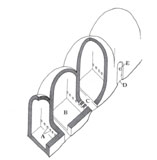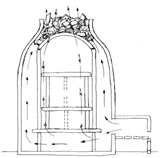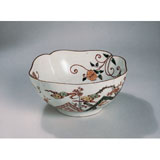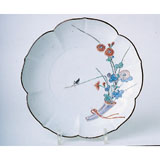 Noborigama
kiln Noborigama
kiln- An Oriental
type of climbing chamber kiln built on an incline so that the heated
gases from the lower chambers passes through and heats the upper chambers
thus increasing the efficiency of the use of fuel. As the lower chamber
reaches the target temperature, the temperature of the next chamber
up is boosted to its target by further firing in its own firebox.
-
 Muffle
kiln Muffle
kiln- A small
kiln enclosing a permanent container made of refractory material in
which ceramic objects can be heated to moderate temperatures through
radiation and conduction of heat and protected from flame, flyash and
corrosive gases. These kilns are often used to fire enamel and lustre
ware.
-
- Imari
(1)
- The name
of the port on the northwestern tip of Kyushu Island, close to Arita,
from where the porcelain produce was shipped to other parts of Japan
and to the port of Nagasaki for onward distribution by the Dutch and
the Chinese.
-
 Imari
(2) Imari
(2)- A category
of enamelware developed for the Japanese export trade with a variety
of types.
Features:
- The
enamel could be painted on objects with and without underglaze blue.
- The
decoration usually covered a large area of the surface.
- The
palettes often used a characteristic red and gold.
- After
1700 many Imari wares showed a pinkish blush.
- As
well as the usual flower and animal designs, one sees patterns taken
from textiles.
So popular were the Imari wares that the Chinese potters later copied
the style and it was also imitated in European ceramic design.
- Kakiemon
(1)
- The name
of a particular kiln site at Nangawara in S.W. Arita where porcelain
pots were fired and decorated in the Kakiemon palettes. Only shards of
open shaped vessels are found at this site so closed shapes with Kakiemon
enamels were produced elsewhere. It is likely that this kiln was not
founded until 1670.
-
- Kakiemon
(2)
- The name
of the head of the Sakaida family who own the kilns at Nangawara.
-
 Kakiemon
(3) Kakiemon
(3)- The name
given to a category of enamelware made mainly for the export market.
Features:
- Sparse
decoration in cobalt blue with or without enamel decoration.
- Well-placed,
pictorial painting of flowers, birds and landscape with delicate
brushwork.
- Mostly
rounded shapes although polygonal and irregular shapes known.
- Some
have a very fine, white porcelain (nigoshide) body and were reserved
for decoration with enamels alone, without underglaze blue.
- Generally
the body is white with a good clear glaze.
|

